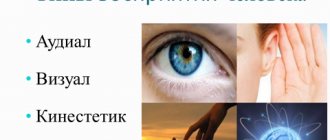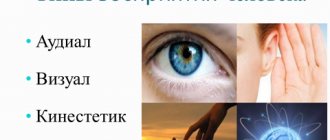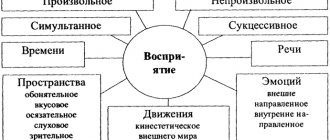Every day, every person is bombarded with a huge amount of information. We encounter new situations, objects, phenomena. Some people move smoothly through this flow of knowledge and successfully use it to their advantage. Others find it difficult to remember something. This situation is largely related to a person’s belonging to a certain type in terms of information perception. If it is presented in a form that is inconvenient for humans, its processing will be extremely difficult.
What is information?
The concept of “information” has an abstract meaning and its definition largely depends on the context. Translated from Latin, this word means “clarification”, “exposition”, “knowledge”. Most often, the term “information” refers to new facts that are perceived and understood by a person, and are also recognized as useful. In the process of processing this information received for the first time, people acquire certain knowledge.
How is information received?
Human perception of information is the cognition of phenomena and objects through their influence on various senses. By analyzing the result of the impact of an object or situation on the organs of vision, hearing, smell, taste and touch, a person receives a certain idea. Therefore, the process of perceiving information is based on our five senses. In this case, a person’s past experience and previously acquired knowledge are actively used. By referring to them, the information obtained can be attributed to already known phenomena or isolated from the general mass into a separate category. Methods of perceiving information are based on some processes associated with the human psyche:
- thinking (having seen or heard an object or phenomenon, a person, thinking, realizes what he has encountered);
- will (a person’s ability to organize the process of perception).
- feelings (various types of reactions to objects of perception);
- speech (the ability to name the object of perception);
Presentation of information
Using this parameter, information can be divided into the following types:
- Text. It is presented in the form of all kinds of symbols, which in combination with each other allow you to obtain words, phrases, sentences in any language.
- Graphic arts. Includes charts, graphs, drawings and other images.
- Sound. This is directly oral speech, thanks to which information from one person is transmitted to another and various audio recordings.
- Numerical. This is information represented by numbers and signs that express a certain mathematical operation.
Perception and presentation of information are inextricably linked. Each person tries to choose exactly the option for presenting data that will provide them with better understanding.
Ways of human perception of information
There are many such methods available to humans. They are determined by the five senses: sight, hearing, touch, taste and smell. In this regard, there is a certain classification of information according to the method of perception:
- visual;
- olfactory.
- taste;
- tactile;
- sound;
Visual information is perceived through the eyes. Thanks to them, various visual images enter the human brain, which are then processed there. Hearing is necessary to perceive information received in the form of sounds (speech, noise, music, signals). The organs of touch are responsible for the ability to perceive tactile information. Receptors located on the skin make it possible to estimate the temperature of the object under study, the type of its surface and its shape. Information about taste enters the brain from receptors on the tongue and is converted into a signal by which a person understands what kind of product it is: sour, sweet, bitter or salty. The sense of smell also helps us understand the world around us, allowing us to distinguish and identify all types of odors. Vision plays a major role in the perception of information. This is about 90% of the knowledge gained. The healthy way of perceiving information (for example, radio transmission) accounts for about 9%, and the other senses are responsible for only 1%.
Gregory's Visual Inference Theory
Psychologist Richard Gregory (1970) was convinced that visual perception depends on top-down processing.
Top-down processing, or conceptually driven processing, occurs when we form a picture of the big picture from small details. We make assumptions about what we see based on expectations, beliefs, prior knowledge, and previous experiences. In other words, we are making an educated guess.
Gregory's theory is supported by numerous evidence and experiments. One of the most famous examples is the hollow mask effect:
When the mask is turned to the hollow side, you see a normal face
Gregory used Charlie Chaplin's rotating mask to explain how we perceive the hollow surface of a mask as bulges based on our beliefs about the world. According to our previous knowledge of facial structure, the nose should protrude. As a result, we subconsciously reconstruct the hollow face and see a normal one.
How do we perceive visual information according to Gregory's theory?
1. Almost 90% of information received through the eyes does not reach the brain. Thus, the brain uses previous experience or existing knowledge to construct reality.
2. The visual information that we perceive is combined with previously stored information about the world that we have acquired through experience.
3. Based on various examples of the theory of top-down information processing, it follows that pattern recognition is based on contextual information.
Tip: Enhance your content with an appropriate theme and design; use a meaningful headline to set key expectations; Support your visuals with expressive text.
- Why do stereotypical landing pages and websites convert better?
Types of perception
The same information received in a certain way is perceived differently by each person. Someone after a minute of reading one of the pages of a book will be able to easily tell the content, while others will remember practically nothing. But if such a person reads the same text out loud, he will easily reproduce what he heard in his memory. Such differences determine the characteristics of people’s perception of information, each of which is inherent in a certain type. There are four in total:
- Visual effects.
- Discrete.
- Kinesthetics.
- Audial.
It is often very important to know what perception of information is dominant for a person and how it is characterized. This significantly improves mutual understanding between people and allows you to quickly and completely convey the necessary information to your interlocutor.
Errors in perception (illusions)
There is nothing perfect in the world, and perception is no exception. For various reasons, this process can “fail” and give the individual erroneous images that do not correspond to reality.
There are two types of such violations:
- illusions are a perverted perception of existing objects and phenomena. Illusions, in turn, are: affectogenic - they are caused by feelings and emotions. For example, an anxious person may see an approaching maniac or monster in the shadow of a tree, hear a threat in someone else’s speech, a shy person will see criticism and shaming everywhere;
- pareidolic - the emergence of fantastic images when interacting with reality (blood in a glass instead of water, beetles instead of dirt stains). This type of illusion is a precursor to hallucinations.
This disorder is independently present only in mentally ill people - psychotics (for example, schizophrenics). The only condition under which a normal person can temporarily see hallucinations is a forced change in mental state (hypnosis, drugs).
Visuals
These are people for whom vision is the main sense organ in the process of learning about the world around them and perceiving information. They remember new material well when they see it in the form of text, pictures, charts and graphs. In the discourse of images, there are often words that are in one way or another connected with the characteristics of objects by their external characteristics, the very function of vision (“we see”, “light”, “bright”, “we will see”, “it seems to me”). These people usually speak loudly, quickly and at the same time gesticulate actively. The images pay great attention to their appearance and surroundings.
How to take care of them
Hygiene of the sense organs greatly influences their development and health. There is a list of basic rules that must be followed to protect your receptors and analyzers. Let's look at them for each organ.
Vision
To maintain the normal condition of your eyes, you should:
- use good lighting for reading;
- no smoking;
- Healthy food;
- visit an ophthalmologist at least once a year;
- if your doctor has recommended that you wear glasses or contacts, do not ignore these recommendations;
- lenses or glasses require appropriate care and timely replacement;
- moderate communication with gadgets - no more than 5 hours a day;
- daily eye exercises.
If you follow these simple instructions, you can maintain your good vision or even improve it. It should also be taken into account that vision may deteriorate due to natural trauma. Therefore, do not ignore protective equipment such as glasses or a mask if you work in a factory with welding or machine tools, etc., and also try to avoid contact with bright lights.
Taste
The tongue is a very elastic muscle and one of the strongest in the body. The shell of the tongue is very rough, due to the fact that there are many small papillae on it, which serve as receptors that recognize the taste of food. These receptors are divided into several types, each of which performs its own function:
- mushroom-shaped;
- threadlike;
- groove-shaped;
- conical;
- leaf-shaped.
Here is a list of rules on how to protect each of them:
- wash your hands before eating;
- Drinking hot food or liquid is prohibited;
- do not talk while eating, so as not to accidentally damage the receptors;
- Before eating food, make sure that it does not contain dangerous ingredients, for example, small seeds.
Smell
With the help of our nose we can not only smell pleasant smells. This body also warns us about various threats, such as gas leaks or fires. Therefore, care for this organ should not be neglected. Here is a list of recommendations:
- smoking or passive perception of such an irritant contributes to a deterioration in the sense of smell;
- Dust is very harmful to the nose, so you should carry out wet cleaning and ventilation of the rooms in which you are daily;
- Avoid contact with strong odors, especially from small containers (the smaller the container, the more particles accumulate in it).
Hearing
In order to protect your hearing, you need to follow 3 rules:
- you should not listen to loud music;
- try to clean your ears daily using cotton swabs and rinse them with water;
- Do not use sharp objects to clean your ears, otherwise there is a risk of tearing the membrane.
Touch
The skin has the main function of protecting most internal organs from external irritants. Thanks to the skin, we distinguish between heat and cold, and also feel pain. How to protect it?
- try to wash every day;
- make sure your clothes are clean;
- you should also not buy low quality clothes;
- It is prohibited to touch unfamiliar plants and street animals.
By following these rules, you can keep all your senses in good condition.
Audials
It is much easier for people to learn what they have heard once than to see it a hundred times. The peculiarities of such people’s perception of information lie in their ability to listen well and remember what is said, whether in a conversation with colleagues or relatives, or in a lesson at an institute or workshop. Auditory learners have a large vocabulary and are pleasant to communicate with. Such people know how to perfectly convince their interlocutor in a conversation with him. They prefer quiet activities to active pastimes and like to listen to music.
Discrete
The way we perceive information is directly related to human feelings. Most people acquire knowledge through sight, hearing, touch, smell and taste. However, the types of information perception include those that are primarily associated with thinking. People who perceive the world around them in this way are called discrete. There are quite a few of them, and they are found only in adults, since logic is not sufficiently developed in children. At a young age, the main ways of unnoticed perception of information are visual and auditory. And only with age do they begin to actively reflect on what they saw and heard, discovering new knowledge for themselves.
Type of perception and learning ability
The way people perceive information largely determines what form of learning will be most effective for them. Of course, there are no people who would receive new knowledge exclusively with the help of a sense organ or a group of them, for example, touch and smell. They all act as a means of perceiving information. However, knowing which sense organs are dominant in a particular person allows others to quickly convey the necessary information to him, and the person himself allows him to effectively organize the process of self-education.
For example, images should present all new information in a readable form, in the form of images and diagrams. In this case, they remember much better. Paintings usually outperform the hard sciences. Even as children, they are excellent at solving puzzles, know many geometric shapes, and are good at drawing, painting, and building with blocks or a builder.
Auditory learners, on the other hand, more easily perceive information received from spoken language. This could be a conversation with someone, a lecture, or an audio recording. When teaching a foreign language to the general public, audio courses are preferable to a printed self-taught manual. If you still need to remember the written text, it is better to say it out loud.
Kinesthetic learners are very mobile. They find it difficult to concentrate on anything for long. These people find it difficult to learn material learned at a conference or from a textbook. The memorization process will go faster if kinesthetic learners learn to combine theory and practice. It is easier for them to study sciences such as physics, chemistry, biology, in which a specific scientific term or law can be presented as the result of a laboratory experiment.
Reticent people take a little longer than other people to take new information into account. They must first understand it, connect it with their past experiences. These people might, for example, record a teacher's lesson on a tape recorder and listen to it a second time later. There are many scientists among discrete people, since rationality and logic are paramount to them. Therefore, in the learning process they will be closer to those subjects on the accuracy of which the perception of information depends, for example, computer science.
The phenomenon of binocular rivalry
Binocular rivalry occurs when we see two different images at the same location. One of them dominates, and the second is suppressed. Dominance alternates at certain intervals. So, instead of seeing a combination of two pictures at the same time, we perceive them in turn, as two images competing for dominance.
In a 1998 experiment, Frank Tong, Ken Nakayama, J. Thomas Vaughan, and Nancy Kanwisher concluded that if you look at two different images at the same time, the effect of binocular rivalry occurs.
Four trained people took part in the experiment. As stimuli, they were shown images of a face and a house through glasses with red and green filters. During the perception process, there was an irregular alternation of signals from the two eyes. The subjects' stimulus-specific responses were monitored using functional magnetic resonance imaging (MRI).
How do we perceive visual information according to Tong's experiment?
- According to MRI data, all subjects showed active binocular rivalry when they were shown dissimilar pictures.
- In our visual system, the binocular rivalry effect occurs during visual processing. In other words, during the short period of time when the eyes are looking at two dissimilar images located close to each other, we are not able to determine what we are actually seeing.
David Carmel, Michael Arcaro, Sabine Kastner and Uri Hasson conducted a separate experiment and found that binocular rivalry can be manipulated using stimulus parameters such as color, brightness, contrast , shape, size, spatial frequency or speed.
Manipulating contrast in the example below causes the left eye to perceive a dominant image, while the right eye perceives a suppressed image:
How does contrast affect our visual perception according to the experiment?
- Manipulating contrast causes the stronger stimulus to be dominant for a greater amount of time.
- We will see a fusion of the dominant image and part of the suppressed one until the effect of binocular rivalry arises.
Tip #3: Don't overload your content; use themed icons; highlight key points.
- Everything you need to know about design principles and types
Role in communication
The types of information you receive also influence how best to communicate with someone so that they will listen to you. For images, the appearance of the interlocutor is very important. The slightest carelessness in clothing can drive him away, after which it doesn’t matter what he says. When talking with a visual learner, you need to pay attention to facial expressions, speak quickly using gestures, and support the conversation with schematic drawings.
In a conversation with the auditor, there should be words that are close to him (“listen to me,” “looks tempting,” “talks a lot”). The perception of information by a human auditor largely depends on how the interlocutor speaks. The timbre of the voice should be calm and pleasant. If you have a bad cold, it is better to postpone an important conversation with the auditor. These people also do not tolerate harsh notes in their voices.
Negotiations with a kinesthetic agent should be carried out in a room with a comfortable air temperature and a pleasant smell. These people sometimes need to touch the other person so that they can better understand what they hear or see. Don't expect the kinesthetic learner to quickly make a decision immediately after the conversation. He needs time to listen to his feelings and understand that he is doing everything right.
Dialogue with a restrained person should be based on the principle of rationality. It is best to operate with strict scientific facts and rules. For the reserved, the language of numbers is clearer.
The influence of typography and aesthetics on the reading process
Did you know that typography can influence a person's mood and ability to make decisions?
Typography is the design and use of type as a means of visual communication. Nowadays, typography has moved from the field of book printing into the digital sphere. Summarizing all possible definitions of the term, we can say that the purpose of typography is to improve the visual perception of text.
In an experiment, Kevin Larson (Microsoft) and Rosalind Picard (MIT) found out how typography affects a reader's mood and problem-solving ability.
They conducted two studies, each involving 20 people. Participants were divided into two equal groups and given 20 minutes to read an issue of The New Yorker magazine on a tablet. One group received a text with bad typography, the other - with good typography (examples are given below):
During the experiment, participants were interrupted and asked how much time they thought had passed since the start of the experiment. According to psychological research (Weybrew, 1984), people who find their activities enjoyable and are in a positive mood report spending significantly less time reading.
After reading the texts, the experiment participants were asked to solve the candle problem. They had to attach the candle to the wall so that the wax would not drip, using pushpins.
How do we perceive good typography and its impact?
- Both groups of participants misestimated the time spent reading. This means that reading was a fun activity for them.
- Participants who were presented with text with good typography significantly underestimated their reading time compared to participants who were presented with text with poor typography. This means that they found the first text more interesting.
- None of the participants who read the text with poor typography were able to solve the candle problem. While less than half of the second group completed the task. Thus, good typography influenced the ability to solve problems.
Good typography influences the mood of users and their ability to make decisions
Tweet Quote
Tip: use readable fonts; separate text from images; do not overlay pictures or icons on the text; leave enough white space between paragraphs.
- Anatomy of a font: a visual guide to typography









